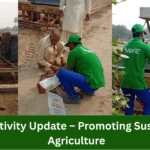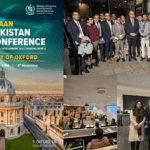
Rice is integral to Pakistan’s agricultural sector, ranking among the top five global rice exporters. With an annual production of over 8 million tons and exports contributing $3.7 billion to the economy, rice plays a pivotal role in the livelihoods of millions of farmers and the country’s foreign exchange reserves. Despite its economic significance, the environmental footprint of traditional rice farming is a growing concern. High water consumption, substantial methane emissions, and unsustainable practices pose significant threats to Pakistan’s long-term agricultural sustainability.
SAWIE (Sustainable Agriculture and Water Intelligent Ecosystem) is at the forefront of promoting climate-smart agriculture in Pakistan. By implementing innovative practices such as Alternate Wetting and Drying (AWD) and conducting sustainable rice trials, SAWIE is working to reduce greenhouse gas (GHG) emissions, improve water productivity, and support the country’s green transition.
Rice Production Challenges in Pakistan
Rice cultivation in Pakistan occupies approximately 3.5 million hectares, contributing to 29% of the national water footprint. The crop is primarily grown in Punjab and Sindh provinces, with Punjab accounting for 69% of total production. However, this expansion in rice cultivation has brought several sustainability challenges:
Water Use Inefficiency: Rice farming in Pakistan consumes 60% of the country’s irrigation water but contributes only 1% to GDP. Traditional practices of continuous flooding create significant water wastage and evaporative losses, threatening freshwater resources.
Methane Emissions: Paddy fields under continuous flooding create anaerobic conditions, generating methane—a greenhouse gas 25 times more potent than CO2. Rice production is responsible for 10–20% of global agricultural methane emissions, with Pakistan contributing a significant share due to its traditional practices.
Groundwater Depletion: Over 50% of irrigation in Punjab relies on groundwater, leading to declining aquifer levels. In Sindh, where groundwater quality is unsuitable, competition for surface water is straining availability for rice farmers.
Policy and Pricing Gaps: Water pricing reforms in Punjab aimed at promoting diversification have had limited impact due to low water rates. Subsidies for solar-powered tube wells, introduced to reduce operational costs, have inadvertently increased groundwater over-extraction.
SAWIE’s Efforts in Climate-Smart Rice Farming
To address these challenges, SAWIE is pioneering sustainable rice production practices with a focus on Alternate Wetting and Drying (AWD). This innovative water management technique involves periodic drying of rice fields, significantly reducing water use and methane emissions. Key highlights of SAWIE’s efforts include:
1. Sustainable Rice Trials
SAWIE is conducting field trials to demonstrate the benefits of AWD. Initial findings reveal that AWD can:
- Reduce water usage by up to 30% without compromising yields.
- Lower methane emissions by 30–70%, aligning with Pakistan’s commitments under the Global Methane Pledge.
2. Capacity Building
SAWIE equips farmers, researchers, and agricultural agencies with the knowledge and tools to adopt AWD. By offering training programs and workshops, SAWIE empowers stakeholders to monitor, report, and verify AWD practices effectively.
3. Integration with Carbon Markets
AWD is recognized as a viable method under international carbon markets. SAWIE is working to develop a transparent system for monitoring and verifying GHG reductions, enabling farmers to benefit from carbon credits. This initiative aligns with global sustainability trends, particularly in European markets that emphasize low-carbon agricultural products.
4. Advanced Technologies
SAWIE is piloting remote sensing and automated water level monitoring systems to simplify AWD adoption. These technologies provide real-time data, helping farmers optimize irrigation schedules and reduce groundwater overuse.
The adoption of AWD offers numerous benefits for Pakistan’s rice sector:
Economic Gains: Reduced water usage and operational costs improve profitability for farmers, while access to carbon markets offers additional revenue streams.
Environmental Benefits: Lower methane emissions contribute to climate change mitigation, while improved water productivity reduces pressure on freshwater resources.
Compliance with Global Standards: Meeting sustainability benchmarks enhances Pakistan’s competitiveness in international markets, ensuring the long-term growth of rice exports.
While AWD shows promise, several barriers need to be addressed:
Awareness and Knowledge Gaps: Limited understanding of AWD’s benefits hinders widespread adoption. SAWIE’s outreach programs aim to bridge this gap by demonstrating AWD’s effectiveness through field trials.
Infrastructure Constraints: Smallholder farmers often lack on-farm water storage systems, making it challenging to implement AWD. SAWIE advocates for policy support to develop shared water infrastructure.
Policy Alignment: Existing subsidies and water pricing mechanisms must be restructured to incentivize water-saving technologies.
The Road Ahead: SAWIE’s Vision
SAWIE envisions a resilient and sustainable rice production system in Pakistan that is aligned with global climate goals and national priorities. By scaling AWD adoption, improving data accuracy for GHG inventories, and fostering international collaborations, SAWIE is driving a green transition in agriculture.
With Pakistan’s rice exports poised to grow further, adopting climate-smart practices is not just an environmental imperative—it is an economic opportunity. SAWIE’s efforts in promoting sustainable rice farming offer a blueprint for other crops and regions, making Pakistan a leader in climate-smart agriculture.
News
Advancing Climate-Smart Rice Cultivation in Pakistan: SAWIE’s Vision for Low-Carbon Agriculture
Rice is integral to Pakistan’s agricultural sector, ranking among the top five global rice exporters. With an annual production of over 8 million tons and exports contributing $3.7 billion to the economy, rice plays a pivotal role in the livelihoods of millions of farmers and the country’s foreign exchange reserves. Despite its economic significance, the environmental footprint of traditional rice farming is a growing concern. High water consumption, substantial methane emissions, and unsustainable practices pose significant threats to Pakistan’s long-term agricultural sustainability.

Top News
SAWIE (Sustainable Agriculture and Water Intelligent Ecosystem) is at the forefront of promoting climate-smart agriculture in Pakistan. By implementing innovative practices such as Alternate Wetting and Drying (AWD) and conducting sustainable rice trials, SAWIE is working to reduce greenhouse gas (GHG) emissions, improve water productivity, and support the country’s green transition.
Rice Production Challenges in Pakistan
Rice cultivation in Pakistan occupies approximately 3.5 million hectares, contributing to 29% of the national water footprint. The crop is primarily grown in Punjab and Sindh provinces, with Punjab accounting for 69% of total production. However, this expansion in rice cultivation has brought several sustainability challenges:
Water Use Inefficiency: Rice farming in Pakistan consumes 60% of the country’s irrigation water but contributes only 1% to GDP. Traditional practices of continuous flooding create significant water wastage and evaporative losses, threatening freshwater resources.
Methane Emissions: Paddy fields under continuous flooding create anaerobic conditions, generating methane—a greenhouse gas 25 times more potent than CO2. Rice production is responsible for 10–20% of global agricultural methane emissions, with Pakistan contributing a significant share due to its traditional practices.
Groundwater Depletion: Over 50% of irrigation in Punjab relies on groundwater, leading to declining aquifer levels. In Sindh, where groundwater quality is unsuitable, competition for surface water is straining availability for rice farmers.
Policy and Pricing Gaps: Water pricing reforms in Punjab aimed at promoting diversification have had limited impact due to low water rates. Subsidies for solar-powered tube wells, introduced to reduce operational costs, have inadvertently increased groundwater over-extraction.
SAWIE’s Efforts in Climate-Smart Rice Farming
To address these challenges, SAWIE is pioneering sustainable rice production practices with a focus on Alternate Wetting and Drying (AWD). This innovative water management technique involves periodic drying of rice fields, significantly reducing water use and methane emissions. Key highlights of SAWIE’s efforts include:
1. Sustainable Rice Trials
SAWIE is conducting field trials to demonstrate the benefits of AWD. Initial findings reveal that AWD can:
- Reduce water usage by up to 30% without compromising yields.
- Lower methane emissions by 30–70%, aligning with Pakistan’s commitments under the Global Methane Pledge.
2. Capacity Building
SAWIE equips farmers, researchers, and agricultural agencies with the knowledge and tools to adopt AWD. By offering training programs and workshops, SAWIE empowers stakeholders to monitor, report, and verify AWD practices effectively.
3. Integration with Carbon Markets
AWD is recognized as a viable method under international carbon markets. SAWIE is working to develop a transparent system for monitoring and verifying GHG reductions, enabling farmers to benefit from carbon credits. This initiative aligns with global sustainability trends, particularly in European markets that emphasize low-carbon agricultural products.
4. Advanced Technologies
SAWIE is piloting remote sensing and automated water level monitoring systems to simplify AWD adoption. These technologies provide real-time data, helping farmers optimize irrigation schedules and reduce groundwater overuse.
The adoption of AWD offers numerous benefits for Pakistan’s rice sector:
Economic Gains: Reduced water usage and operational costs improve profitability for farmers, while access to carbon markets offers additional revenue streams.
Environmental Benefits: Lower methane emissions contribute to climate change mitigation, while improved water productivity reduces pressure on freshwater resources.
Compliance with Global Standards: Meeting sustainability benchmarks enhances Pakistan’s competitiveness in international markets, ensuring the long-term growth of rice exports.
While AWD shows promise, several barriers need to be addressed:
Awareness and Knowledge Gaps: Limited understanding of AWD’s benefits hinders widespread adoption. SAWIE’s outreach programs aim to bridge this gap by demonstrating AWD’s effectiveness through field trials.
Infrastructure Constraints: Smallholder farmers often lack on-farm water storage systems, making it challenging to implement AWD. SAWIE advocates for policy support to develop shared water infrastructure.
Policy Alignment: Existing subsidies and water pricing mechanisms must be restructured to incentivize water-saving technologies.
The Road Ahead: SAWIE’s Vision
SAWIE envisions a resilient and sustainable rice production system in Pakistan that is aligned with global climate goals and national priorities. By scaling AWD adoption, improving data accuracy for GHG inventories, and fostering international collaborations, SAWIE is driving a green transition in agriculture.
With Pakistan’s rice exports poised to grow further, adopting climate-smart practices is not just an environmental imperative—it is an economic opportunity. SAWIE’s efforts in promoting sustainable rice farming offer a blueprint for other crops and regions, making Pakistan a leader in climate-smart agriculture.



